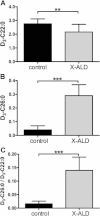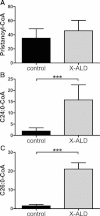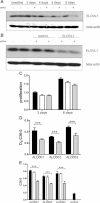The role of ELOVL1 in very long-chain fatty acid homeostasis and X-linked adrenoleukodystrophy
- PMID: 20166112
- PMCID: PMC3377275
- DOI: 10.1002/emmm.201000061
The role of ELOVL1 in very long-chain fatty acid homeostasis and X-linked adrenoleukodystrophy
Abstract
X-linked adrenoleukodystrophy (X-ALD) is caused by mutations in the ABCD1 gene encoding the peroxisomal ABC transporter adrenoleukodystrophy protein (ALDP). X-ALD is characterized by the accumulation of very long-chain fatty acids (VLCFA; > or =C24) in plasma and tissues. In this manuscript we provide insight into the pathway underlying the elevated levels of C26:0 in X-ALD. ALDP transports VLCFacyl-CoA across the peroxisomal membrane. A deficiency in ALDP impairs peroxisomal beta-oxidation of VLCFA but also raises cytosolic levels of VLCFacyl-CoA which are substrate for further elongation. We identify ELOVL1 (elongation of very-long-chain-fatty acids) as the single elongase catalysing the synthesis of both saturated VLCFA (C26:0) and mono-unsaturated VLCFA (C26:1). ELOVL1 expression is not increased in X-ALD fibroblasts suggesting that increased levels of C26:0 result from increased substrate availability due to the primary deficiency in ALDP. Importantly, ELOVL1 knockdown reduces elongation of C22:0 to C26:0 and lowers C26:0 levels in X-ALD fibroblasts. Given the likely pathogenic effects of high C26:0 levels, our findings highlight the potential of modulating ELOVL1 activity in the treatment of X-ALD.
Figures

D3-C22:0 levels in control versus X-ALD cell lines.
D3-C26:0 levels in control versus X-ALD cell lines.
D3-C26:0/D3-C22:0 ratio in control versus X-ALD cell lines.
Eight control and 25 X-ALD cell lines were cultured for 72 h with 50 µM D3-C16:0. Fatty acids are in nmol/mg protein. Data are mean ± SD. **p < 0.01, ***p < 0.001 by unpaired student's t-test.

Pristanoyl-CoA levels in control versus X-ALD cell lines.
C24:0-CoA levels in control versus X-ALD cell lines.
C26:0-CoA levels in control versus X-ALD cell lines.
Fatty acyl-CoAs are in pmol/mg protein. Data are mean ± SD in 3 control and 6 X-ALD cell lines. ***p < 0.001 by unpaired student's t-test.

ELOVL1 mRNA expression in 6 control and 9 X-ALD cell lines. Data are mean ± SD.
ELOVL1 protein expression in control and X-ALD cell lines. (+) positive control: CHO cells expressing ELOVL1.

ELOVL1 expression in X-ALD fibroblasts cultured for 3, 4, 5 or 6 days in medium devoid of (−) or supplemented with (+) ELOVL1 siRNA.
ELOVL1 expression in X-ALD fibroblasts which were untransfected (−) or transfected (+) with siRNA targeting either cyclophilin-B (control) or ELOVL1.
Effect of control siRNA (white bars) or ELOVL1 siRNA (grey bars) on cell proliferation in comparison with untransfected cells (black bars).
D3-C26:0 levels in ELOVL1 siRNA transfected (grey bars) versus untransfected (black bars) X-ALD fibroblasts.
C26:0 levels in control and X-ALD fibroblasts which were untransfected (black bars) and in X-ALD fibroblasts which were transfected with either control siRNA (white bars) or ELOVL1 siRNA (grey bars). Fatty acids are in nmol/mg protein. Data are mean ± SD. ***p < 0.001 by unpaired student's t-test.
Similar articles
-
HDAC inhibitor SAHA normalizes the levels of VLCFAs in human skin fibroblasts from X-ALD patients and downregulates the expression of proinflammatory cytokines in Abcd1/2-silenced mouse astrocytes.J Lipid Res. 2011 Nov;52(11):2056-69. doi: 10.1194/jlr.M017491. Epub 2011 Sep 4. J Lipid Res. 2011. PMID: 21891797 Free PMC article.
-
Impaired very long-chain acyl-CoA β-oxidation in human X-linked adrenoleukodystrophy fibroblasts is a direct consequence of ABCD1 transporter dysfunction.J Biol Chem. 2013 Jun 28;288(26):19269-79. doi: 10.1074/jbc.M112.445445. Epub 2013 May 13. J Biol Chem. 2013. PMID: 23671276 Free PMC article.
-
Bezafibrate lowers very long-chain fatty acids in X-linked adrenoleukodystrophy fibroblasts by inhibiting fatty acid elongation.J Inherit Metab Dis. 2012 Nov;35(6):1137-45. doi: 10.1007/s10545-012-9471-4. Epub 2012 Mar 24. J Inherit Metab Dis. 2012. PMID: 22447153 Free PMC article.
-
Biochemical aspects of X-linked adrenoleukodystrophy.Brain Pathol. 2010 Jul;20(4):831-7. doi: 10.1111/j.1750-3639.2010.00391.x. Brain Pathol. 2010. PMID: 20626744 Free PMC article. Review.
-
[Adrenoleukodystrophy: molecular pathogenesis and development of therapeutic agents].Yakugaku Zasshi. 2007 Jul;127(7):1059-64. doi: 10.1248/yakushi.127.1059. Yakugaku Zasshi. 2007. PMID: 17603264 Review. Japanese.
Cited by
-
The impact of a ketogenic diet and liver dysfunction on serum very long-chain fatty acids levels.Lipids. 2013 Apr;48(4):405-9. doi: 10.1007/s11745-013-3761-y. Epub 2013 Jan 31. Lipids. 2013. PMID: 23371825
-
Therapeutic potential of deuterium-stabilized (R)-pioglitazone-PXL065-for X-linked adrenoleukodystrophy.J Inherit Metab Dis. 2022 Jul;45(4):832-847. doi: 10.1002/jimd.12510. Epub 2022 May 19. J Inherit Metab Dis. 2022. PMID: 35510808 Free PMC article.
-
HDAC inhibitor SAHA normalizes the levels of VLCFAs in human skin fibroblasts from X-ALD patients and downregulates the expression of proinflammatory cytokines in Abcd1/2-silenced mouse astrocytes.J Lipid Res. 2011 Nov;52(11):2056-69. doi: 10.1194/jlr.M017491. Epub 2011 Sep 4. J Lipid Res. 2011. PMID: 21891797 Free PMC article.
-
Endocrine dysfunction in adrenoleukodystrophy.Handb Clin Neurol. 2021;182:257-267. doi: 10.1016/B978-0-12-819973-2.00018-6. Handb Clin Neurol. 2021. PMID: 34266597 Free PMC article. Review.
-
Pathophysiology of X-linked adrenoleukodystrophy.Biochimie. 2014 Mar;98(100):135-42. doi: 10.1016/j.biochi.2013.11.023. Epub 2013 Dec 4. Biochimie. 2014. PMID: 24316281 Free PMC article. Review.
References
-
- Asheuer M, Bieche I, Laurendeau I, Moser A, Hainque B, Vidaud M, Aubourg P. Decreased expression of ABCD4 and BG1 genes early in the pathogenesis of X-linked adrenoleukodystrophy. Hum Mol Genet. 2005;14:1293–1303. - PubMed
-
- Aubourg P, Adamsbaum C, Lavallard-Rousseau MC, Rocchiccioli F, Cartier N, Jambaque I, Jakobezak C, Lemaitre A, Boureau F, Wolf C. A two-year trial of oleic and erucic acids (“Lorenzo's oil”) as treatment for adrenomyeloneuropathy. N Engl J Med. 1993;329:745–752. - PubMed
-
- Cartier N, Hacein-Bey-Abina S, Bartholomae CC, Veres G, Schmidt M, Kutschera I, Vidaud M, Abel U, Dal-Cortivo L, Caccavelli L, et al. Hematopoietic stem cell gene therapy with a lentiviral vector in X-linked adrenoleukodystrophy. Science. 2009;326:818–823. - PubMed
-
- Engelen M, Ofman R, Mooijer PAW, Poll-The BT, Wanders RJA, Kemp S. Cholesterol-deprivation increases mono-unsaturated very long-chain fatty acids in skin fibroblasts from patients with X-linked adrenoleukodystrophy. Biochim Biophys Acta. 2008;1781:105–111. - PubMed
Publication types
MeSH terms
Substances
LinkOut - more resources
Full Text Sources
Other Literature Sources
Molecular Biology Databases

